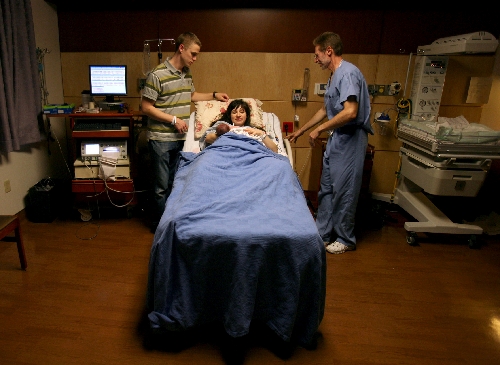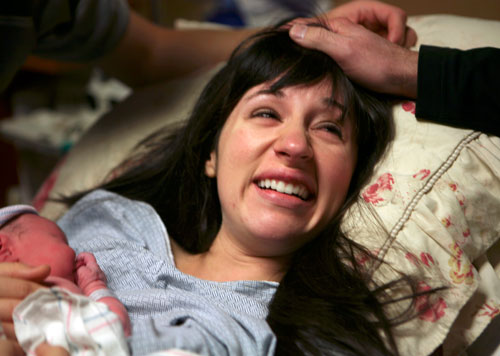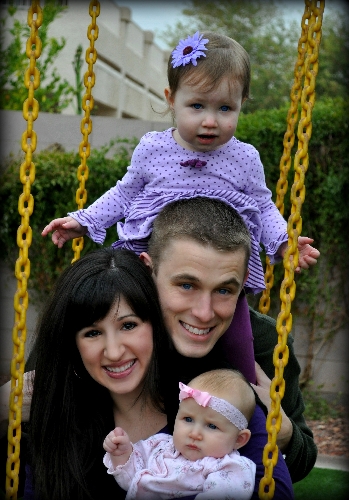Las Vegas doctors, women try to change C-section approach



The elevator doors weren’t fully open, but Dr. Steven Harter was already off and running.
"Here we go," he said to no one in particular, pushing up the glasses on his nose as he picked up speed.
That Summerlin Hospital scene is so routine that some nurses chant "Run, Forrest, Run" when Harter hustles by on his way to deliver a baby.
In his off time, the 51-year-old obstetrician laughs at the good-natured comparison to Forrest Gump, but right now he’s stone-faced. Wearing sneakers, scrubs and a white coat, he sprints down the hallway to Chelsea Graham’s room.
Moments before, he had learned that the heart rate of Graham’s unborn child had dropped. Two weeks overdue with her second child, Graham, 25, had been in labor about 10 hours on this November day.
Harter, whose office adjoins the hospital, called a coordinator to make sure an operating room was open and an anesthesiologist and surgical team were standing by for an emergency cesarean section, by which Harter could deliver the fetus with a surgical incision through Graham’s abdominal wall and uterus.
Her first child had been delivered by C-section, but this time Graham wanted what few Nevada women have an opportunity to experience — a vaginal birth after a C-section. Obstetricians refer to this as a VBAC, and Harter had agreed to try to help Graham accomplish just that.
It’s not without a small risk — less than 1 percent of the time in such deliveries a life-threatening rupture can occur along the scar left by the previous cesarean, so the American College of Obstetricians and Gynecologists has issued safety guidelines that Harter carefully follows.
Harter, who slept at the hospital in case Graham ran into serious trouble with her labor, had told her that if there was any evidence of risk to her or the baby, he’d do another C-section.
A COMMON PROCEDURE
C-sections are the most common surgical procedure in American hospitals — about one in three births come via a surgeon’s scalpel — with more than 1.4 million performed each year. In Nevada the practice is even more common, at 36 percent of births.
While the ideal rate of cesareans is not known, public health officials suggest an appropriate number of no higher than 15 percent, largely because C-sections pose a risk of surgical complications and a greater chance of problems or death for both mother and baby.
Many women who have had C-sections share Graham’s desire to give birth without surgery in a subsequent pregnancy. Studies since 2006 found that nearly half of American women are interested in a VBAC, yet nearly 92 percent ended up having another cesarean.
More than 46 percent of the 12,000 C-sections in Nevada in 2010 — there were 34,000 births — were repeats. That number reflects the long-held belief of many physicians — one hotly debated by some women — that in the interest of safety "once a C-section, always a C-section."
"I just want to have a bonding experience with my baby right away, to hold my child and breast feed," Graham said in the days before her labor. "I want my body to do what it’s supposed to do. And I don’t want the feeling of hardly being able to walk for weeks after a C-section. I hurt so bad after that surgery."
A woman’s chance of having a VBAC has become increasingly slim, despite a U.S. Department of Health and Human Services’ Healthy People 2010 report that suggested that 37 percent of annual deliveries should be VBACs.
In Nevada, just 261 women who had prior C-sections — 160 of them from Las Vegas — gave birth in 2010 without surgery. That translates to just 0.77 percent of total deliveries.
Nationwide, the number of VBACs has dropped from a high of 28 percent in 1996 to less than 10 percent today. Meanwhile, repeat C-sections across the country have risen to about 40 percent of all cesareans.
WHAT DO THE STUDIES REALLY SAY?
With women and doctors so interested in safety issues regarding VBACs, researchers from around the world continually conduct studies about their relative safety in comparison to repeat C-sections.
Sometimes they appear contradictory.
The most recent study of 2,232 pregnancies from Australia — released three weeks ago — revealed two unexplained stillbirths in the VBAC group but no infant deaths among those who had repeat C-sections. The rate of fetal or infant death or serious health issues was 2.4 percent in the VBAC group, compared to 0.9 percent in the repeat C-section group.
An earlier study found that babies born vaginally after a C-section have less than a 1 percent higher risk of stillbirth than those born by a repeat cesarean.
But a scientific review conducted 20 years ago of 31 published studies, including 11,417 trials of labor, found no difference in death rates for mother and child in VBACs and repeat cesareans.
While mothers in the Australian VBAC group had more bleeding problems, other studies have shown that the risk of maternal death in a VBAC is lower — 0.02 percent for a VBAC and 0.04 percent for repeat C-sections.
Harter, one of the few doctors in Las Vegas who regularly attends VBACs, said he doubts that the new Australian study will change either the positions of the medical establishment or women on the relative safety of VBACs and repeat C-sections.
Death and serious health issues associated with either delivery method are rare, he said.
"I always spend a lot of time talking to women about the risks involved," he said.
Magdalena Alvarez, a midwife who helps operate Pink Peas, a center that helps women decide what childbirth method is best for them, said the Australian study does not appear to be significant enough to advise women against VBACs. She said she will advise women to do what she always does — look carefully at studies, "particularly who pays for them."
Dr. Catherine Spong, of the National Institute of Child Health and Human Development, wrote a companion piece to the Australian study that stressed the need to prevent the first cesarean. She said it is critical that women have discussions with obstetricians so they can weigh relative risks.
"I can think of nothing more important," she said.
The main worry with a VBAC remains the risk of uterine rupture during labor, which can severely harm both the mother and the child and requires emergency surgery. Studies have shown that rupture occurs in 0.7 percent of cases where a common low transverse incision, called a bikini cut, has been made. And the number of catastrophic cases is low — 1 in 2,000 babies die or suffer brain damage as result of oxygen deprivation.
CHANGING GUIDELINES
Dr. Jeffrey Wrightson, chief of obstetrics at University Medical Center, remembers when doctors in Nevada and nationwide began to do more VBACs.
It was after a 1980 conference held by the National Institutes of Health to combat skyrocketing C-section rates. Researchers had the statistics to prove it could be done successfully.
Soon, the VBAC rate, which had been around 5 percent, began to climb. By 1996 they accounted for 28 percent of births from C-section veterans. At the end of the decade, the government issued the Healthy People 2010 report calling for a target VBAC rate of 37 percent.
But then, Wrightson noted, some high-profile ruptures were followed by some major lawsuits, and the American College of Obstetricians and Gynecologists in 1999 changed its guidelines, which medical centers generally follow.
The new key stipulation called for surgeons and anesthesiologists be "immediately available" to perform an emergency C-section during a VBAC. Until then, they only had to be "readily available."
It was no longer enough for doctors to be within a half-hour drive.
Hospital officials interpreted "immediately available" to mean a doctor and anesthesiologist had to be on the hospital campus whenever a VBAC labor was under way.
"Changing that one word from ‘readily’ to ‘immediately’ made all the difference," Wrightson said.
Insurance companies picked up on the new stipulation’s sense of crisis. Some companies stopped offering malpractice coverage to doctors attending the procedures. Other carriers jacked up the price of malpractice coverage. The lack of coverage, coupled with doctors’ fear of litigation and the skyrocketing cost of what insurance was available, is estimated to have caused half of the nation’s obstetricians to stop attending VBACs.
Obstetricians with a small practice saw no way to remain financially viable if they stayed at a hospital for hours with one patient, Wrightson said, so only a handful of Las Vegas obstetricians took patients that wanted a VBAC.
Hospitals across the country said having staff standing by for whenever a patient might attempt a VBAC was too costly, so many didn’t allow them.
In an attempt to increase the number of vaginal deliveries after C-sections, the American College of Obstetricians and Gynecologists issued guidelines in 2010 saying a VBAC is a safe and appropriate choice for most women who have had a prior C-section, including for some women who have had two.
But because the college did not change its "immediately available" stipulation regarding staffing at hospitals, the number of women attempting VBACs has not risen significantly.
Wrightson said he suspects that for the most part, only hospitals staffed 24/7 with an obstetrician and anesthesiologist will do VBACs.
‘HE GOES WAY ABOVE AND BEYOND’
No obstetrician is more dedicated in Las Vegas to giving women the choice of a VBAC than Harter.
Even though he’s married with three children, Harter attends about a quarter of the city’s VBACs each year, sometimes literally living at Summerlin Hospital for days at a time. He coordinates with an anesthesiologist.
"I think it’s important that women have this chance if they want it," Harter said. "Many women tell me how important it is that they have a natural birthing experience. So when they’re in labor, I’m at the hospital. I’m very lucky to have an understanding wife."
Almost half of the VBACs take place at UMC, the University of Nevada School of Medicine’s teaching hospital, which has ob-gyns and anesthesiologists on staff around the clock.
Wrightson said he believes UMC should start marketing itself as a center of the VBAC birthing experience.
Dr. K. Warren Volker, who has the largest ob-gyn practice in Las Vegas, said he intends to do the same thing at Sunrise.
Sunrise spokeswoman Stacy Acquista put it this way: "At Sunrise Children’s Hospital there is 24/7 OB Hospitalist coverage in-house to handle deliveries in the event that a patient’s primary obstetrician is not available. In the event that the patient’s primary OB cannot be present, the decision to perform a VBAC is done collaboratively between the OB hospitalists and the patient’s primary OB, and they remain in constant communication regarding any concerns."
The doctor most often brought up in positive way by women in support groups at either the Well Rounded Mama or Pink Seas pregnancy center is Harter. Most women say they’ve searched and searched for a doctor who will do a VBAC, and he’s often the only one they can find. They realize that his commitment means fewer patients, affecting his bottom line.
"I think what he does for women is just amazing," said Dr. Tammy Reynolds, who received her VBAC care from Harter "He goes way above and beyond to help women get the experience they desire."
No official statistics are available for VBACs attended by midwives or doulas, who provide labor support, but doula Tiffanie Gonzales said "the numbers are increasing all the time. Women are fed up."
Wrightson said it is ironic that the issuance of more stringent guidelines for VBACs — supposedly done to ensure a higher level of care — "has apparently driven more and more women into the lowest level of care."
Both Wrightson and Harter say a uterine rupture is frightening and can’t be handled by a midwife.
"You’ve only got a couple of minutes to get it under control," Harter said. The woman hemorrhages and the baby is cut off from both blood and oxygen as the placenta detaches.
"The uterus has a huge blood supply going to it so the bleeding is considerable," said Harter.
Harter said he agrees with guidelines calling for a surgeon and anesthesiologist to be immediately available at the hospital: "You don’t have time to get to the hospital if a rupture occurs."
PROOF IT CAN BE DONE
As her pretty 4½-month-old daughter, Elliotte, sat quietly in her lap, Chelsea Robbins told the packed crowd gathered at the Well Rounded Mama how wonderful her home birth was, how much better she thinks a midwife is for childbirth than a physician.
"I was in the birth tub and the pain just melted away," she said. "My husband rubbed my back. It was so different from being in the hospital for my first birth with people who really don’t care about you. You’re with your child right away."
Michelle Van Norman, who had two earlier C-sections, talks about the delightful home birth experience she had with her third child: "You bond so much better with your child in a natural birth."
Women in the audience, most of them thinking of trying a vaginal delivery after earlier C-sections, listen intently, many of them nodding at their husbands as a speaker describes her VBAC.
The delivery risk is touched on, but only as the speaker says the risk with VBACs is greatly exaggerated, bemoans that more than nine out of 10 births following a C-section are now surgical deliveries, and criticizes doctors and hospitals in Las Vegas for not making VBACs readily available.
"I’m living proof it can be done safely," Robbins said.
OFF TO A RUNNING START
It is early in the morning on Nov. 4 as Cheryl Coccimiglio sits in a Summerlin Hospital waiting room with her husband and prays that her daughter Chelsea won’t have to have another C-section.
She is impressed that Harter is devoted to giving a woman a birthing experience as natural as possible.
Coccimiglio had Chelsea by C-section, she noted, but she had successful VBACs with her next three children.
"I wanted this for her so much," she said. "I know she had a sense of failure with her first one, that she believes her body wasn’t given an opportunity to do what it was designed to do. I’m just glad Dr. Harter is willing to invest so much time in this."
Out in the hallway, the elevator chimed, and Harter, a devoted long-distance runner, was off at the bell.
When he got to Chelsea’s room, he found his patient with her doula, Gonzales. They had grunted the baby’s head into the birth canal.
The distress that the nurse noted early on the fetal monitoring equipment didn’t indicate a uterine rupture was imminent.
Soon, Harter was using a vacuum extractor to guide the baby out of the birth canal.
At 11:01 a.m., amid happy tears from Chelsea and her husband, Hudson, their little girl, Olivia — all beautiful 7 pounds, 14 ounces of her — came into this world without being cut from her mother’s belly.
"I did it!" Chelsea Graham cried as she held her baby. "I did it!"
Contact reporter Paul Harasim at pharasim@reviewjournal.com or 702-387-2908.
Part 1C-sections: Some question whether surgery occurs only for medical necessity
C-sections Counted
• 33 – Percentage of births in U.S. done by c-section
• 36 – Percentage of births in Nevada done by c-section
• 15 – Appropriate percentage of births by c-section, according to health officials












